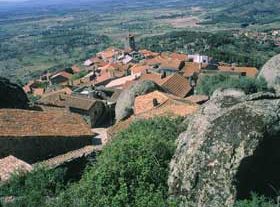Dinossaurs in Região do Oeste (western region)
Dinossaurs in Região do Oeste (western region)
Other
Perhaps not many people realise that the Lourinhã region, bordering the Atlantic and where we now head down to the sandy beaches spilling out from its spectacular river valleys, was once a favoured haunt of Upper Jurassic period dinosaurs as they roamed this part of the earth some 150 million years ago.
These wonderful terrestrial beings, which Man never came into contact with, lived in what has since become the Western region of Portugal among its many water courses and rich vegetation. These were ideal conditions and fostered the development of the kind of dinosaurs that now so amaze us.
As this area was at that time shrinking and consequently being filled with sediment, any skeletons were being rapidly covered and thus fossilised.
Throughout the many millions of years that separate us from the Upper Jurassic period, these sediments have again been pushed upwards. A process that has been speeded up by the impressive archaeological excavations carried out by both Portuguese and international palaeontologists.
The Museum of Lourinhã, one of the major organisers of such digs, is now famous for its palaeontological collection in addition to having a large fossil treatment laboratory, a replica workshop and has, since 2000, run an annual international dinosaur illustration competition.
In 1993, Paimogo was the site of the discovery of the largest nest of dinosaur eggs in the world and the only eggs ever found in Europe to contain embryos, and a highly rare find by any standards. Come and discover their story.
Image: Vladimir Bondar / Museu da Lourinhã
These wonderful terrestrial beings, which Man never came into contact with, lived in what has since become the Western region of Portugal among its many water courses and rich vegetation. These were ideal conditions and fostered the development of the kind of dinosaurs that now so amaze us.
As this area was at that time shrinking and consequently being filled with sediment, any skeletons were being rapidly covered and thus fossilised.
Throughout the many millions of years that separate us from the Upper Jurassic period, these sediments have again been pushed upwards. A process that has been speeded up by the impressive archaeological excavations carried out by both Portuguese and international palaeontologists.
The Museum of Lourinhã, one of the major organisers of such digs, is now famous for its palaeontological collection in addition to having a large fossil treatment laboratory, a replica workshop and has, since 2000, run an annual international dinosaur illustration competition.
In 1993, Paimogo was the site of the discovery of the largest nest of dinosaur eggs in the world and the only eggs ever found in Europe to contain embryos, and a highly rare find by any standards. Come and discover their story.
Image: Vladimir Bondar / Museu da Lourinhã




 Explore
Explore 
 Remember and Share
Remember and Share 


